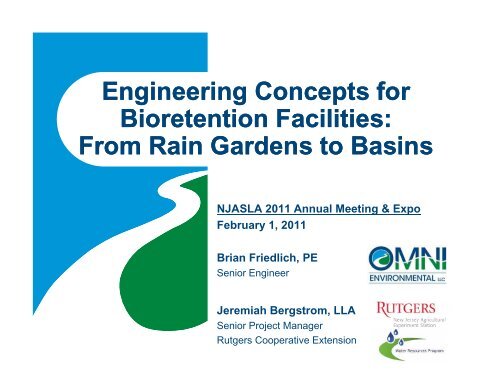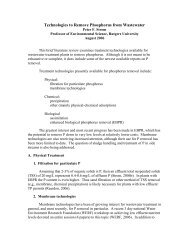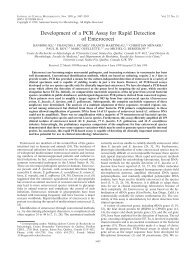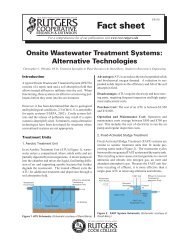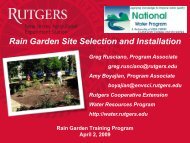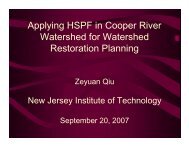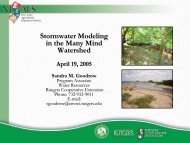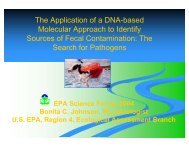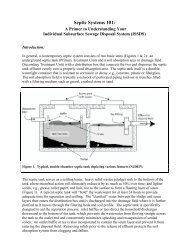Engineering Concepts for Bioretention Facilities - Rutgers ...
Engineering Concepts for Bioretention Facilities - Rutgers ...
Engineering Concepts for Bioretention Facilities - Rutgers ...
You also want an ePaper? Increase the reach of your titles
YUMPU automatically turns print PDFs into web optimized ePapers that Google loves.
<strong>Engineering</strong> <strong>Concepts</strong> <strong>for</strong><br />
<strong>Bioretention</strong> <strong>Facilities</strong>:<br />
From Rain Gardens to Basins<br />
NJASLA 2011 Annual Meeting & Expo<br />
February 1, 2011<br />
Brian Friedlich, PE<br />
Senior Engineer<br />
Jeremiah Bergstrom, LLA<br />
Senior Project Manager<br />
<strong>Rutgers</strong> Cooperative Extension
Overview of Presentation<br />
Innovative Stormwater Management - LID<br />
The <strong>Bioretention</strong> ti Concept<br />
Applications<br />
Basins<br />
Rain Gardens<br />
Village School <strong>Bioretention</strong>/Rain Garden Case<br />
Study<br />
Questions
The Urban Water Cycle<br />
Figure taken from http://www.manukauwater.co.nz
Conventional Stormwater Design<br />
Figure taken from http://www.michiganlakeinfo.com
LID Stormwater Design<br />
Figure taken from http://www.michiganlakeinfo.com
Conventional vs. LID<br />
Conventional Concrete-Lined Channel<br />
<strong>Bioretention</strong> Swale in LID Design
Conventional vs. LID<br />
Conventional Detention Basin<br />
<strong>Bioretention</strong> Basin in LID Design
Conventional vs. LID<br />
Conventional On-Lot Stormwater Management<br />
Rain Garden (Small <strong>Bioretention</strong> Cell)
Other <strong>Bioretention</strong> Applications<br />
Formal Planting Beds<br />
Parking Lot Medians<br />
Low-Traffic Streetscapes<br />
High-Traffic Streetscapes
Hydrologic Benefits of <strong>Bioretention</strong><br />
• Reduce peak flows<br />
• Reduce runoff volume<br />
• Reduce flooding<br />
• Convey stormwater to<br />
downstream receiving waters<br />
• Miti Maintain pre-development groundwater recharge<br />
• Mimic pre-development hydrology
Treatment Processes of <strong>Bioretention</strong><br />
• Settling/Filtration<br />
<br />
<br />
Stokes’ Law<br />
Added benefit of dense vegetation and check dams<br />
• Sorption – <strong>Bioretention</strong> Media<br />
<br />
<br />
<br />
Absorption<br />
Adsorption<br />
Precipitation<br />
• Trans<strong>for</strong>mation<br />
<br />
<br />
ii i <strong>Bioretention</strong> Treatment Efficiencies:<br />
Bioremediation<br />
Phytoremediation<br />
Pollutant<br />
% Removal<br />
Suspended Solids 90%<br />
Total Phosphorus 70% to 83%<br />
Total Nitrogen 68% to 80%<br />
BOD 60% to 80%<br />
Lead 93% to 98%<br />
Zinc 93% to 98%<br />
Hydrocarbons 90%
<strong>Bioretention</strong> Basins vs. Rain Gardens<br />
• While used interchangeably, terms have different connotations:<br />
<strong>Bioretention</strong> Basins<br />
Rain Gardens<br />
• Engineered, larger-scale systems<br />
• Traditional outlets with hydraulic controls<br />
• Specialized bioretention media <strong>for</strong><br />
planting soil<br />
• Gravel underdrain layer when used on<br />
poorly drained soils<br />
• Smaller-scale systems, frequently used<br />
on residential lots<br />
• Simple overland outlets/overflows<br />
• Soil amendments <strong>for</strong> planting bed<br />
• Shallower ponding depths on poorly<br />
drained soils
Design of <strong>Bioretention</strong><br />
Basins
The <strong>Bioretention</strong> Basin Concept<br />
NJDEP. 2004. NJ Stormwater BMP Manual.
NJ Stormwater Management Reg’s<br />
• Runoff Quantity<br />
Peak flows must not exceed 50, 75, and 80% of the existing peak flows in the 2-, 10-,<br />
and 100-year storm events, unless the proposed hydrograph is less than the existing<br />
hydrograph at all times during storm events.<br />
• Runoff Quality<br />
Stormwater BMPs must be designed to treat 80% of the annual total suspended<br />
solids (TSS) loads.<br />
• Recharge<br />
Existing recharge must be maintained or exceeded <strong>for</strong> the proposed p site.<br />
• Nonstructural Strategies (LID)<br />
Nonstructural strategies, such as cluster development and vegetative conveyance,<br />
g p g y<br />
must be used to the maximum extent practicable.
General Design Considerations<br />
• Pretreatment<br />
• Groundwater<br />
• Seasonal High Water Table<br />
• Perched Water Table<br />
• Native Soils<br />
• Permeability<br />
• Karst Formations<br />
• Existing Topography and Ecological Function<br />
• Steep Slopes<br />
• Existing Mature Trees<br />
• Wetlands
NJDEP BMP Manual Design Details
Typical <strong>Bioretention</strong> Outlet Detail<br />
OVERFLOW WEIR<br />
~ 1 ft.<br />
LOW-FLOW OUTLET,<br />
CAPPED<br />
BASIN BOTTOM<br />
PRECAST CONCRETE<br />
STORMWATER OUTLET<br />
STRUCTURE<br />
PERFORATED PVC<br />
UNDERDRAIN SYSTEM
Infiltration Through <strong>Bioretention</strong> Media<br />
0 Hours<br />
(Assuming Infiltration Rate of 4.0 inch/hour)<br />
12” ponding depth<br />
2 Hours<br />
4” ponding depth<br />
4 Hours<br />
No Standing Water<br />
20” Saturated (40% void)<br />
Fully Saturated
Routing <strong>Bioretention</strong> Systems<br />
• Surface Pond<br />
• <strong>Bioretention</strong> Media<br />
• Stone Layer and Underdrain<br />
• Outlet Structure/Weir
Hydrologic Design Steps<br />
1. Site Investigation/Soil Testing – Establish SHWT & Native Soil Permeability<br />
2. Use engineering judgment to decide if underdrain is needed – depends on design<br />
goals and native soil permeability (
Planting Media Specification<br />
1996:<br />
2002:<br />
2009:<br />
Clay: 10 to 25%<br />
Silt: 30 to 55%<br />
Sand: 35 to 60%<br />
Clay: < 15%<br />
Silt: < 30%<br />
Sand: > 65%<br />
Clay: 2 to 5%<br />
Silt + Clay:
<strong>Bioretention</strong> Basin Vegetation<br />
• Simulated terrestrial <strong>for</strong>ested community<br />
• Tall Grasses<br />
• Shrubs<br />
• Herbaceous Species<br />
• Trees<br />
• Native vegetation<br />
• Diverse species<br />
• Salt tolerant<br />
• Flood adaptable
Construction Considerations<br />
• Compaction<br />
• <strong>Bioretention</strong> media<br />
• Underlying soils<br />
• Light earthmoving equipment<br />
• Clogging of <strong>Bioretention</strong> Media<br />
• Stabilize drainage area prior to installation<br />
• 2-foot rule when using basin <strong>for</strong> sedimentation during construction<br />
• Post-Construction Infiltration Testing
Maintenance Considerations<br />
• Routine Inspections<br />
• Structures<br />
• Vegetation<br />
• Hydrology<br />
• Vegetation Maintenance<br />
• Weeding<br />
• Cutting Grasses<br />
• Sediment & Trash Removal<br />
• Inlet and Outlet Structures<br />
• Pipes in Drainage System
<strong>Bioretention</strong> Basin Case Study<br />
Tenacre <strong>Bioretention</strong> Basin<br />
Princeton, New Jersey
<strong>Bioretention</strong> Basin Design Plan
<strong>Bioretention</strong> Basin Design Details
<strong>Bioretention</strong> Basin Construction
<strong>Bioretention</strong> Basin Construction
<strong>Bioretention</strong> Basin Construction
<strong>Bioretention</strong> Basin Construction
<strong>Bioretention</strong> Basin Construction
<strong>Bioretention</strong> Basin Construction
<strong>Bioretention</strong> Basin Construction
<strong>Bioretention</strong> Basin Construction
<strong>Bioretention</strong> Basin Construction
<strong>Bioretention</strong> Basin Construction
Design of Rain Gardens
What is a Rain Garden?<br />
A rain garden is a landscaped, shallow depression<br />
that is designed to intercept, treat, and infiltrate<br />
stormwater at the source be<strong>for</strong>e it becomes<br />
runoff. The plants used in the rain garden are<br />
native to the region and help retain pollutants that<br />
could otherwise harm nearby waterways.
Rain Garden Schematic
Rain Garden Placement<br />
The rain garden should be at least 10 feet from<br />
the house so infiltrating water doesn’t seep into<br />
the foundation.<br />
Do not place the rain garden directly over a<br />
septic system.<br />
Do not put rain garden in places where water<br />
already ponds.<br />
Place in full or partial sunlight.<br />
Select a flat part of the yard <strong>for</strong> easier digging.
Rain Garden Placement<br />
http://clean-water.uwex.edu/pubs/raingarden/rgmanual.pdf
Rain Garden Ponding Depth<br />
Between four and eight inches deep<br />
Depth depends upon lawn slope<br />
If the slope is less than 4%, it is<br />
easiest to build a 3 to 5-inch deep rain<br />
garden.<br />
If the slope is between 5 and 7%, it is<br />
easiest to build one 6 to 7 inches<br />
deep.<br />
If the slope is between 8 and 12%, it is<br />
easiest to build one about 8 inches<br />
deep.
Other Considerations<br />
Is the soil type suitable?<br />
percolation test/infiltration t/i ti testt<br />
texture test/soil type test<br />
Is the rain garden able to handle the<br />
drainage area?<br />
if not, consider multiple rain gardens
Size of the Rain Garden<br />
The size of the rain garden is<br />
a function of volume of runoff<br />
to be treated and recharged.<br />
Typically, a rain garden is<br />
sized to handle the water<br />
quality design storm: 1.25<br />
inches of rain over two hours.<br />
A typical residential rain<br />
A typical residential rain<br />
garden ranges from 100 to<br />
300 square feet.
Example in Sizing<br />
Problem:<br />
How big does a rain garden need to be to<br />
treat the stormwater runoff from my<br />
driveway?
25 50<br />
Driveway<br />
House<br />
25<br />
50<br />
10<br />
Driveway Area<br />
50' x 15' = 750 square feet<br />
25' x 10' = 250 square feet<br />
Total Area = 1,000 square feet<br />
15<br />
One-Quarter of the Roof<br />
25' x 12.5' = 312.5 square feet
Example in Sizing<br />
Drainage Area = 1,000 square feet<br />
1.25 inches of rain = 0.1 feet of rain<br />
1,000 sq. ft. x 0.1 ft. = 100 cubic feet of water<br />
<strong>for</strong> the design storm<br />
Let’s design a rain garden that is 6 inches deep<br />
Answer:<br />
10 ft wide x 20 ft long = 200 square feet
Rain Garden Sizing Table<br />
<strong>for</strong> NJ’s Water Quality Design Storm<br />
Area of Impervious Size of 6” deep Rain Size of 12” deep Rain<br />
Surface to be Treated Garden<br />
Garden<br />
(ft 2 )<br />
(ft 2 ) or [w x d] (ft 2 ) or [w x d]<br />
500 100 or 10’x10’ 50 or 10’x5’<br />
750 150 or 15’x10’ 75 or 10’x7½’<br />
1,000 200 or 20’x10’ 100 or 10’x10’<br />
1,500 300 or 30’x10’ 150 or 15’x10’<br />
2,000 400 or 20’x20’ 200 or 20’x10’
How much water can we treat?<br />
90% of rainfall events are less than 1.25”<br />
New Jersey has approx. 44” of rain per year<br />
The rain garden will treat and recharge:<br />
09x44” 0.9 =40”/year = 3.33 ft/year<br />
The rain garden receives runoff from 1,000 sq.ft.<br />
Total volume treated and recharged by the rain garden is<br />
1,000 sq. ft. x 3.3 ft. = 3,300 cubic feet, which is 25,000<br />
gallons per year<br />
Build 40 rain gardens and we have treated t and<br />
recharged 1,000,000 gallons of water per year!
Rain Garden: Maintenance Issues<br />
• Repair planting soil bed if erosion occurs.<br />
• Core aerate or cultivate unvegetated areas<br />
annually if surface becomes clogged with fine<br />
sediments.<br />
• Apply mulch twice per year until groundcover<br />
establishes.<br />
• Replace dead or diseased plant material.<br />
• Inspect/remove any sediment<br />
buildup/trash/leaves at inflow and outflow<br />
devices on monthly basis.<br />
• Do NOT fertilize – unless you do a soil test!
Rain Gardens in NJ?<br />
• Gardens should be designed to capture 1.25” of<br />
rain.<br />
• Maximum water depth should range from 6 to<br />
12”<br />
• Size should be 3 to 10% of contributing<br />
watershed (e.g., a 1,250 sq. ft. house footprint –<br />
125 sq. ft. garden that has a maximum water<br />
depth of 1 ft.)<br />
• Install an underdrain system where soils are not<br />
suitable <strong>for</strong> infiltration<br />
• Double shredded hardwood mulch 4” thick
Rain Garden Plantings<br />
Swamp Milkweed<br />
Bee Balm<br />
Soft Rush<br />
Photos by Linda Brazaitis
Rain Garden Plantings<br />
Blue Flag<br />
Iris<br />
Cardinal<br />
Flower<br />
Bald Cypress<br />
Shasta Daisy
Rain Garden Case Study<br />
Lawrence Nature Center Rain<br />
Garden Demonstration<br />
Lawrence, New Jersey
Village School Courtyard Rain<br />
Gardens<br />
Holmdel, New Jersey
Village School Site<br />
Originally planned as a small educational rain garden<br />
project as part of Ramanessin Brook 319(h) grant.<br />
After walking the school property, p scope expanded to a<br />
more involved courtyard design project.<br />
Project Goals:<br />
Reduce runoff volumes leaving the site through infiltration in<br />
rain gardens.<br />
Improve stormwater treatment with filtration through soil.<br />
Decrease flows and erosion downstream.<br />
Provide science/nature educational setting.
Village School - Aerial<br />
Courtyard Rain<br />
Gardens Project Area
Village School Site
Village School Site
Village School Site
Village School Site
Village School Site
Educational Program
Educational Program
Educational Program
Educational Program
Questions<br />
Brian Friedlich, PE<br />
Senior Engineer<br />
Omni Environmental, LLC<br />
bfriedlich@omni-env.comenv com<br />
Jeremiah Bergstrom, LLA, ASLA<br />
Senior Project Manager<br />
<strong>Rutgers</strong> Cooperative Extension Water Resources Program<br />
jbergstrom@envsci.rutgers.edu


